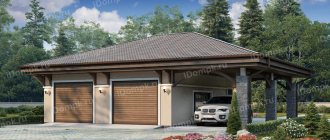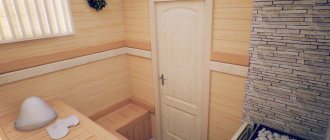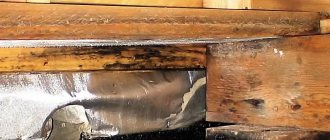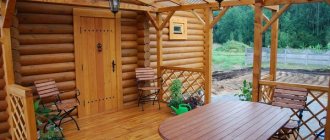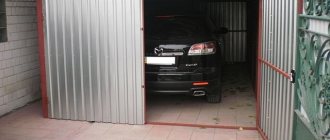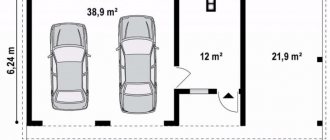Having an attached car storage extension to your home has its own benefits that make it so popular. These benefits are quite simple and are as follows:
- built together with the house;
- there is no need for your own foundation and additional rafters;
- the style decision is dictated by the architecture of the house;
- the attached garage acts as an extension of the wall of the house, without standing out in any way;
- there is no need for cable channels and trenches below the ground freezing level, since electricity is supplied from a residential building;
- heating through connection to a common boiler;
- lower costs of building materials due to the fact that one of the four walls is common with the house;
- entrance through the living area.
But, with all the advantages of such a garage, there are also disadvantages that should be taken into account when making the final choice in favor of one solution or another:
- the distance between the fence and the house is unacceptable, which is less than five meters, which car owners do not always like;
- when a garage is built separately, this can lead to cracks in the walls of the house, as well as settlement of the foundation due to the lack of calculations during its construction - additional soil analysis cannot be avoided;
- the need to take into account additional vibration from machines, especially large ones;
- turning the site into a roadway due to the significant distance from the entrance gate;
- requirements for the presence of a full-fledged fire alarm and smoke detectors - fire safety rules provide for this due to the storage of fuels and lubricants in the garage;
- mandatory laying of a fire-resistant brick wall adjacent to the house;
- availability of additional output.
As you can see, most of the disadvantages of adding a garage are associated with particularly strict fire safety requirements for buildings with such an arrangement.
The durability and convenience of an additional structure of this kind depend not least on the quality of the selected materials. Before you start purchasing, answer several important questions:
- is there a need for a full-fledged garage or shelter from precipitation;
- Is there time to lay a full-fledged foundation or is a building made of lightweight materials built in a few days enough?
- is there a need for a permanent garage;
- Is saving on materials important?
Having answered them, they begin to select the main material for building walls. For a permanent garage, brick is considered the best option. Unlike cellular foam concrete, whose installation is simple but requires post-processing, it does not require this. There is no need to protect it from the corrosion that metal is susceptible to. At the same time, brickwork thicker than one-and-a-half is not needed - even that is enough to protect the car.
Choosing the optimal location
When starting to design an extension, evaluate the possibility of connecting utilities to the existing highways in the building. The garage space must be provided with:
- Water supply and wastewater disposal system.
- Reliable electrical wiring.
- Heating (for year-round use).
- Fire alarm system.
Installing a reliable fire alarm in your garage should not be ignored. A garage attached to a house is a source of additional danger caused by the storage of fuels and lubricants next to the living space.
Having worked out the communications supply diagram, decide on the location. An extension to the garage house should not violate the integrity of the visual perception of the existing structure. The main requirements that will allow you to avoid mistakes when building a garage:
- place the building on the left or right side of the main entrance to the house. By combining both buildings under a single roof, you will achieve a harmonious look;
- decide on the number of inputs and outputs. It is recommended by fire safety rules to organize an emergency exit. Cover a wall shared with a residential building with fireproof materials. The option of combined construction is beneficial from the point of view of heat exchange - the wall adjacent to the garage will be warm. The presence of an additional door will provide direct access to the garage during bad weather;
The garage can be located on the right or left side of the main building, just to provide the car with the shortest path from the entrance to the parking lot
- do not skimp on arranging the foundation. There is an opinion that due to the small mass of the structure, the foundation can be made shallow. We do not recommend checking whether such conclusions correspond to reality. A strong foundation with an increased safety margin will not hurt. After all, in addition to the mass of the structure, loads will act on the foundation when the car moves.
Advantages of an extension
Sheds can be of different sizes: from a small shelter for 1 car space to structures made entirely around the garage. Some people simply make a canopy in front of the gate.
In any case, such a shelter will bring many benefits to the owner.
Here are just some of the advantages:
- A canopy in front of the garage will protect you from bad weather and precipitation. You won’t have to spend a lot of time clearing the roadway near the gate if it snowed the day before.
- Under the canopy you can carry out minor car repairs if the garage itself is cluttered, and there will be much more space around.
- Sometimes you can just have a nice time under a canopy. Set up a table, invite friends and sit without fear of bad weather.
The construction takes 1-2 days, and you can even bring the materials in your own car.
Organization of the garage extension process
After the location of the garage extension to the house has been determined, no matter which one, foam blocks or wood, we begin organizing the construction process.
First of all, you should start by drawing up a project for the future construction, indicating on it all the necessary structural elements, dimensions and pieces of furniture, if any, are intended.
Basic rules of construction
Before attaching a garage to the house, you should take into account a number of nuances and rules with the help of which the implementation of this idea will be as effective as possible.
Among the main factors:
- The first thing you need to take care of is fire safety. As mentioned earlier, for this purpose, the walls adjacent to the garage are treated with special fire-resistant materials.
- It is advisable to attach a garage to the house when the house and the gate are separated by a short distance. Otherwise, most of the personal space will have to be used to construct the entrance area, which will create uncomfortable conditions for moving around the site.
- The location where construction is planned must comply with a number of construction requirements and standards. These points relate primarily to the location of window and door openings of a residential building and the structure attached to it.
As for the latter, the requirements for the construction of a garage in close proximity to a residential building, we are talking about the following standards:
- the ridge of the garage roof must be located at a distance of at least 2 meters from the window opening of a residential building;
- the distance between the doors and windows of the house and the attached garage should be 2.5 m;
- the space from the structure being erected to the site located next door must be at least 5 m.
Important nuances
In addition, a fundamental point in the implementation of this idea is to obtain the appropriate permission. All residential buildings are entered into the register during construction.
If the design of a building is modified without complying with legal norms, in the future it will be extremely difficult, and even impossible, to carry out any legal procedures with such a building.
For example, the owner of the house will not be able to sell the house, draw up a deed of gift or a will for it. That is why it is very important to timely legalize the addition of a garage to the house.
In addition, sometimes such issues are resolved in a negative way for the homeowner and for some reason he is denied the implementation of such a construction process. And, if the building is already attached to the house, then, in case of refusal, it will have to be demolished or penalties will be paid.
Bottom line
At the end of our publication I would like to summarize:
- Adding a garage to your home provides many advantages: from saving space to comfort, which makes it possible to quickly and easily get to your car.
- On the other hand, for such a building to serve faithfully, it is necessary to follow a number of rules for constructing an extension.
- By adhering to the tips and recommendations described above, you can attach a garage to a residential building without the help of qualified builders.
We hope our article will help you realize your plans in the best possible way. Good luck!
The process of building a garage: materials and tools
After completing the necessary papers and completing the design of the construction plan for such a garage, the time comes to purchase the necessary tools and materials.
The most durable and environmentally friendly option in this sense is brick. The construction of a brick garage begins with the wall of a residential building.
There is also an option to assemble a garage from sip panels - a method that is quick and easy to implement. There are also strict requirements for the wood used in roof sheathing - it must be completely dry and smooth, without knots. Video instructions for building a roof over a garage:
How to attach a garage to the house, having funds in your wallet for the most modest option?
Scheme of the foundation of a garage and a house
Use metal plates as material. However, such material is unreliable, and a garage built from it will also be short-lived.
The set of tools will be represented by the usual household assortment - a hammer, self-tapping screws, screwdrivers, a hammer drill, shovels, and so on - as well as a container for mixing cement, crushed stone, sand - in the event that the pouring will be done manually. The builder also needs to acquire reinforcement, wire and logs for the base of the frame of the garage itself. Such exotic equipment as a welding machine and an automatic concrete mixer will be used once.
A separate topic for discussion is the coupling of the frame of the future garage.
The fact is that the foundation of a garage attached to a house, despite its simple strip-formwork structure, must be fastened to the main foundation of the house in a certain way. This fastening ensures the stability of the garage-house structure both when the garage foundation hardens and during its further operation.
Installation of load-bearing structures of the canopy
Before installing the canopy, the strength of the entire structure must be calculated. It is important to make the extension so that the garage door can open easily. Before installation begins, the construction site is prepared. Excess trash is removed. They cut down the grass that interferes with construction.
When the place is ready, the dimensions of the future canopy are measured. After this, you can begin to dig holes for the posts on which the rafter system under the canopy will be attached. The frequency of digging holes for the posts directly depends on the weight of the roof. If it is made of heavy materials such as slate, then the distance between the holes is no more than 80 cm.
When using lighter roofing material (polycarbonate or soft roofing), the distance can be maintained within 1.2-1.5 m.
The pillars must be dug to a depth of more than 1 m. To increase the service life of the structure and prevent its collapse, the pillars must be coated with waterproofing. These can be either special chemicals or simple bitumen. The poles themselves are made of timber (10-18 cm), metal pieces of pipes or angles at least 3 m long.
The supports should be leveled. It is better to start installation from the wall closest to the garage. First, one support is installed vertically on the right side of the garage. Access to the garage is checked again. It is important that there is enough space left for the garage door and its opening. When the level is set, the post is compacted in the hole using stones. This must be done carefully so as not to knock the level down. When the post is securely fixed, it is filled with cement solution and allowed to dry for about 2 hours.
This sequence of setting and digging is applicable for all the following support pillars.
Two pillars are level. Now you can set up two more extreme pillars located near the road. They should also be installed level. Only they are not positioned relative to each other, but along the sides on which the installation is carried out. That is, the rightmost pole, which is located near the road, is placed along the right support to the garage, the left one is similar, only on the other side.
After setting 4 starting posts, a thread is pulled between the two supports on each side. It will help you level the remaining pillars.
When they are all installed, they are measured again with a level. It is better to tie the spans between the supports on one side crosswise using boards or use welding if they are made of metal. At the top, each pair (left and symmetrically located right post) is tied with a board or welded with a long corner.
Foundation – which one to choose? Work technology
The characteristics of the soil do not always allow the construction of a structure without a solid foundation that can absorb and evenly distribute the resulting loads. To ensure that adding a garage to your house does not cause any trouble, take care of a solid foundation. On solid ground, you can lay a columnar foundation. But, most often, preference is given to the tape version - acceptable for all types of soil. Adhering to proven technologies, you can easily cope with the task of forming a foundation for a garage with your own hands:
- clear the construction site of debris. Provide access for transport;
- prepare materials for pouring the foundation (sand, cement, crushed stone, reinforcement);
- prepare wooden panels for the construction of formwork;
- Dig a trench that matches the chosen foundation configuration. Maintain the size in the range of 70-90 cm, choosing the depth based on the amount of soil freezing in your region. A small-sized excavator will help speed up excavation work. Then you only need to trim the vertical walls;
- make a cushion of crushed stone with sand designed to create a waterproofing layer;
- install wooden formwork around the perimeter using available materials;
Attention is drawn to the foundation under the house and its design features
- form a reinforced frame. Connect the reinforcement with tying wire or welding. Install the structure in the trench on a sand-crushed stone base. Make sure that the ends of the reinforcement do not touch the ground to avoid corrosion;
- prepare the concrete composition using fine crushed stone and sand. Pour the foundation. Carry out the work in one step for uniform hardening;
- After the concrete has hardened, remove the formwork.
When connecting a building to an existing building, you should be prepared for the formation of cracks at the point of contact of the foundations caused by shrinkage. There are three ways to minimize these processes:
- Connecting the reinforcing systems of the extension and the house into a single structure. The method guarantees high quality, but is only suitable if work on pouring the foundation of both structures is carried out simultaneously.
- Fastening with metal rods connecting structural elements of buildings.
- Creating conditions for independent shrinkage of each foundation. It is achieved by forming a gap between the bases and then filling it with plastic materials.
Foundation of the house and garage together or separately
Using the same methods as with the main structure of the cottage, it is necessary to correctly select a high-quality, durable and ultra-reliable foundation for the garage. The base of the structure will absorb not only the load from the car, but also absorb part of the pressure from the entire cottage. choose the right foundation for a house with a garage . Do not neglect the help of InnovaStroy architects, who have many years of experience in constructing a variety of modern country houses and cottages.
The first task of any site owner is to decide on the location of a private house with a garage on the territory. According to standard standards, the façade of a cottage should not be closer than 5 meters from the “red line” - that is, from the border of the roadway or sidewalk. This requirement does not apply to garages of any type. Therefore, they can be built closer to the fence, or as part of the entrance group directly from the roadway.
The foundation for a house with a garage is also based on geological surveys. After all, the pressure of the car will be exerted on the ground through the floor surface, so you need to know exactly the composition of the soil and its load-bearing characteristics. The construction of the foundation by qualified InnovaStroy specialists is always based on the results of studies of the site’s soils, groundwater and terrain features.
It would not be a bad idea to consult with your neighbors on the land plot, relatives who have a private house with a garage. This will help you find out:
- what foundation construction methods they used;
- that you want to change;
- Are there any problems with structural integrity and maintenance?
The data you receive can become the basis for an informed choice of foundation types for your cottage.
Naturally, you need to avoid any “experts” who guarantee incredible results when building exactly their type of foundation. It’s better to come to the professional architects of InnovaStroy and ensure that you build a full-fledged foundation for a house with a garage.
In modern practice, with a wide variety of building materials, many directions are used in the construction of reliable foundations. Before starting design, you need to decide on the main questions:
- what exactly will be the foundation under your cottage with a garage;
- Will you build a basement or limit yourself to a low base?
Quite often you can find an option when the foundation of a house with a garage has a combined structure that combines several directions in the structure. For example, a strip version is used under the house, and a slab version is used under the garage. The architect will help calculate the profitability and rationality of such a device after familiarizing himself with the geological survey data.
When creating a basement floor, the floor in the garage will be the floor, which is arranged between the floors. In this case, all the features in the structure of the foundations will be used in the construction of the foundations of the lowest tiers. As a rule, this is a slab type, on which walls and partitions in basements are subsequently erected.
Let's consider choosing a foundation for a house with a garage without a lower tier or any other spaces under the cottage. Today, when constructing a “standard” two-story cottage, the types of foundations described below are used.
Allows you to create the same base for the entire construction spot. In this case, it is possible to separate the heights, since most often the foundation under the garage is slightly lower than under the main parts of the building. The use of formwork with different heights, as well as the construction of foundations in layers, will ensure the required parameters of the structure. Essentially, it is a large solid slab of concrete with reinforced reinforcement inside.
The construction of the described foundations has its negative aspects, the main of which is the cost and volumes of building materials used. Even with a small height of 50-70 centimeters, the costs can be significant. On the other hand, the strength and reliability of such a foundation has very high indicators. Before choosing this type, find out from our company how much a monolithic foundation costs and how to quickly build it on your site.
The second most popular type of foundation for cottages with a garage. It allows you to create base surfaces on which floor slabs will be laid or a monolithic slab will be created. In any case, high-quality construction of a strip foundation has certain advantages. It can be shallow or deep, depending on the surface characteristics of the soil. Strip foundations are cheaper and consume less material. If there are voids inside the structure, all forces acting on the base are evenly distributed throughout the entire foundation. Be it the pressure of the weight of the cottage or the longitudinal impact from the soil and groundwater.
The foundation for building a house with a garage is not as common as all the others. The peculiarity of this type of foundation is that it is installed on fairly unstable and mobile soils. At the same time, the structure of the house itself should not be very heavy, since there are certain restrictions on the loads on piles and lintels. There is, of course, the option to mount vertical supports with high frequency, which will help increase the maximum loads. When building “classic” two-story houses with garages, you can choose a turnkey pile foundation. The price in Moscow at InnovaStroy is very affordable, and allows you to reduce the cost of design and construction of the foundation to 15-20% of the total estimated cost of building a house.
The construction of a cottage with a garage is best left to professionals. Based on the results of geological research and customer requirements, a specialist will be able to calculate the most successful foundation option. At the next stage, the estimated cost for the construction of structures, earthworks and materials is calculated.
It is generally accepted that the cost of constructing foundations covers about 40% of the total construction costs. The price also includes excavation work and laying communications at the base of the house. Plus - when designing, a certain safety margin is necessarily specified for the structure. Agree that it is easier to immediately build a reliable and durable foundation under a house with a garage than to periodically repair it and spend even more money.
the section about the foundation is why the question is actually about the foundation
Is it worth making the foundation for the house and garage as a single unit?
1. common foundation. The house is a heated, warm room, the foundation of the house needs to be insulated from external cold, the garage is a cold room (or with infrequent heating, say, for work), accordingly, if you make one foundation, then the cold from the garage will go into the house, which is not good
2. foundations separately. the roof over the garage is supposed to be a porch roof and must be connected to the house, so it is not clear how individual foundations will behave
and in the 1st and 2nd cases, the question then arises - how to insulate the foundations, everything is clear about the walls of the house - we read the standard for MZUF, but how to cut it off from the foundation of cold rooms?
1. with a solid foundation, place the insulation on the foundation under the cold room in a continuous layer and increase the supporting area of the wall in order to reduce the pressure on the EPS, and then - reinforcing mesh and screed as a floor on the ground
2. with separate foundations, lay 5-10 cm of EPS between them vertically to the freezing depth over the entire width of the blind area
I plan to build a house and garage out of brick or concrete blocks. Number of floors - 3.
The house is combined with a garage. That is, they have the same foundation. In the garage, I intend to maintain a temperature of +5 degrees in winter + dehumidifiers set to the range of 50%-60% or ventilation.
The soil is 20 cm turf, another 10 cm black soil, then clay. Close to groundwater, in spring at a bayonet depth, in summer 7-9 meters.
I intend to make the foundation 60-70 cm wide, 70 cm deep and 30 cm high above ground level. There is a 20 cm sand cushion under the foundation. I reinforce the foundation from below with 12 rods in 4-5 rows in the middle and at the top. I'm thinking of knitting + welding the rods.
I want to enclose the foundation itself in permanent formwork. Plywood 10mm + polystyrene 50mm. Styrofoam inside. I want to level the upper part of the formwork. Next, make a clay castle on the outside, then a sand cushion, then waterproofing made of roofing felt with bitumen or film, then reinforced with a mesh of rods with a pitch of 50 mm and pour it all on a slope. At the end of the blind area, dig a trench and lay a drainage pipe to remove moisture. Inside, the floor is slightly raised with compacted clay, then a sand cushion, waterproofing, a 12-bar mesh and poured with concrete. Leave a 5cm gap from the walls using the same polystyrene foam.
Am I orienting myself correctly? It seems to me that I missed something somewhere. Or maybe it shouldn’t be so complicated?
I would be grateful for advice from professionals!
The construction of a garage, like any other structure, begins with the creation of a foundation - a foundation. A reliable foundation will provide the “house” for your car with the longest possible service life.
Varieties
Several basic types of foundations are common in construction. They differ in the following parameters:
- by the method of support on the soil and configuration;
- on the materials from which the foundation is laid.
Let's look at four main categories of foundations.
The structure of such a base consists of pillars made of stone, rubble (breakstone) or brick. The supports are constructed in increments of approximately 1.2 to 2.5 meters under the most important points of concentration of loads of the future structure (intersection of walls, corners, in places where heavy boiler equipment is installed, etc.). In order to connect individual pillars into a strong structure, beams are placed on top of them, connecting the heads of the posts, resulting in a finished base.
Separately, it is necessary to say about the columnar foundation made using TISE technology. Its principle is to drill wells at the points where the supports are installed, then strengthen them with reinforcement and fill them with concrete mortar. Another name for this base is columnar monolithic. The lower segment of the column (sole) has an extension.
Distinctive characteristics of the foundation:
- Can be used on light soils that are not prone to movement (displacement) and a strong increase in volume (heaving). It performed excellently in deeply frozen heaving soils.
- An excellent solution for the construction of low-rise buildings (timber, panel, frame houses).
- Reasonable price, minimal working time (compared to other types of bases).
- Does not require waterproofing device.
- Suitable for buildings without basements.
- A durable, cheap foundation, intensively practiced in private construction.
Tape
The name of the foundation entirely corresponds to the visual representation of its structure. This is a reinforced concrete strip stretched under all load-bearing external and internal walls of the building.
The production of such a base requires a larger scale of excavation work and the cost of building materials, compared to the analogue described above.
- Shallow strip foundation - suitable for light buildings made of blocks, logs, and frame structures. The depth of location is no more than 70 cm, that is, not below the soil freezing line. Suitable for constant soils or heaving (dispersed) soils that freeze deeply.
- Recessed foundations are installed below the freezing depth. Able to withstand heaving (increase in volume) and soil movement. Suitable for heavy brick, stone and other buildings. If the structure is built from light materials and has a small mass, then it is better not to make such a foundation, since the weight of the structure will be very small for the stability of the foundation during the period of heaving and soil movement.
- Monolithic strip - finished formwork, reinforced with reinforcement, is filled with concrete mortar. Prefabricated strip - a base of large reinforced concrete foundation blocks. Weak point: when constructing a foundation of a complex configuration, some inconveniences may arise. The main advantages of such foundations: operational flexibility (suitable for almost all types of soil and types of buildings), as well as the possibility of constructing cellars, garages and basements.
Pile
This type of foundation is optimal for weak soils, when it is necessary to transfer the load from the building to harder layers. In addition, pile foundations are intensively practiced for the construction of houses on construction sites with slopes and large unevenness. Of course, you can bring in soil and level the construction site. However, the use of piles will be cheaper.
The foundation structure consists of separately located piles connected by a grillage (beam).
By lowering each pile to the calculated depth, you can easily obtain a horizontally flat surface of the beam for building walls.
- Hammers . For the construction of low-rise buildings, they are not practiced due to economic unjustification. Special equipment is required to drive piles into the ground. As a rule, they are used in the construction of industrial and civil structures.
- Bored . A well is drilled in the ground and filled with concrete solution. The upper supporting parts of the piles are set to a certain height and connected with a grillage. Piles can be reinforced or unreinforced.
- Screw . The piles are made of metal; at the end immersed in the ground, special screw blades are provided. They are quite widely practiced in the construction of low-rise buildings, since they make it possible to quickly prepare the foundation.
A powerful and heavy base for the construction of structures made of blocks, logs, and bricks. This type of base is also called floating, and it can be used on almost any soil (including clay, peat and with a high level of heaving). The slab foundation is cast on a sand and gravel bed to the size of the structure or a little larger.
When the soil moves, the base “floats”, which saves the structure from destruction.
- A shallow slab base is constructed on the surface of the soil (only the cushion is prepared). There is no possibility of constructing a basement.
- Recessed slab base. To construct it, a pit is dug, onto the base of which concrete is poured to form a slab. Suitable for buildings with a basement, cellar, garage. Separately, it should be said about the modern slab base - Swedish plate or USHP (insulated Swedish plate).
Its feature is the side edges and bottom insulated with extruded polystyrene foam, communications inside the platform, as well as a “warm floor”. USHP is a heated base for flooring, foundation, and ceiling of the first floor.
Walls can be erected on this slab immediately, and upon completion of construction, the finishing floor covering can be laid.
Choosing a suitable foundation is a task even more responsible and important than the construction of the garage itself (except for a pencil case garage). Since the service life of the entire structure will depend on the reliability, stability and strength of the foundation.
So what type of base should you choose for your garage? Here is a rough set of simple rules:
- If the soil is swampy and the groundwater level is high, then it is better not to build a basement and inspection pit, but to build the foundation either on a slab or on piles.
- Do you live in a permafrost zone? Then build a slab or pile foundation.
- If you do not require a basement and an inspection hole, then you can arrange either a shallow strip foundation or a slab foundation.
- If the site has complex terrain, then a pile foundation with a reinforced concrete grillage is ideal.
- If a basement is required - only a strip foundation.
Due to the fact that a permanent garage can be built from cinder block, brick, gypsum block, foam block, aerated concrete blocks, gas silicate blocks, foam brick, expanded clay concrete blocks, and, as a rule, has small dimensions, it can be built according to hand-drawn diagrams without detailed calculations . But the foundation for the garage must certainly be calculated, since the depth of its foundation determines its wear resistance and load-bearing capacity during operation.
This value depends on:
These indicators are constantly taken into account when calculating the foundation. The main factor is the depth of freezing, as it reflects the level of expansion (heaving) of the soil. Therefore, the depth of foundation (d) is determined by a simple formula: d = depth of soil freezing in the region + 20% (m).
With an increased level of groundwater, the reserve can not be calculated, but pay close attention to the waterproofing of foundation parts.
Be sure to take into account an additional distance for making a sand or gravel cushion - 20-30 cm.
To calculate the width, you need to know what the walls of the garage will be built from. The thickness of the beam or foundation strip should be 20-30% greater than the thickness of the wall (for a wall made of 300 mm blocks, a beam 360-390 mm wide is made along the length of all sides of the foundation).
To calculate the required height of the tape, you need to know what soils are at the base, what the weight of the future building and machine is. The foundation for a garage, the depth of which is determined by the level of freezing, is considered to have a height of +20-30 cm to the resulting value. For hard soils, take approximately 60-80 cm (the total height from the bottom plane of the foundation to the top, excluding the pillow), for heaving soils - 1-1.5 meters.
The length of the piles is calculated according to the principle: soil freezing level + 1.5 meters, approximately 2.5-4 meter products will be required.
The perimeter must be thought out in advance: the minimum permissible length of the walls is 3-6 meters. The optimal option for a garage is 4x7 meters - this will have enough space for the free deployment of a car and the movement of a person.
You can set personal dimensions: add 1-1.5 m to the length and width of the car (or another value that is most optimal for you).
How to do it step by step with your own hands?
The most common type of foundation for a garage is strip foundation. Using his example, we will analyze the step-by-step process of constructing a foundation.
Marking the strip foundation involves creating an angle of 90 degrees. This is done like this:
- According to the plan of the future garage, we determine the location of the right front corner. We hammer in the first peg. This will be the front corner of the garage.
- From it we measure the required distance to the second auxiliary peg and drive it in.
- We stretch a fishing line (rope) between the driven stakes.
- Now we pull the ropes from both pegs at right angles perpendicular to the first line. And we put the third and fourth marks (we drive in stakes).
The result is a rectangle. To check the accuracy of the markings, you can use two methods:
- Measure the rectangle along the diagonals. They must be equal in length.
- From the corner, measure a distance of 3 meters in one direction and 4 meters in the other. With normal marking, the distance between the points will be 5 meters. The exact same check must be done at each corner.
If everything is marked correctly, you won’t have to worry about rearranging pegs from place to place, and you can proceed to the next stage.
We dig a trench. You can dig a ditch with your own hands using a shovel. The bottom of the ditch must be perfectly level. Therefore, use a water level during work.
To create formwork, use sheets of plywood, boards or chipboard, more than 2 cm thick. Knock together the panels and lower them into the ditch on both sides. Secure with wooden blocks. Install spacers of the same length between the panels. This way you will form the same width of the formwork around the entire perimeter.
Place supports on the outside of the formwork. Cover the bottom of the ditch and the side sections of the formwork with waterproofing to prevent liquid from leaking out of the concrete solution.
Concrete M 200-M 300 is suitable for the foundation for a garage. Concrete can be made independently or use factory-made material. A more reliable base will come from a factory solution, because it is quite difficult to follow the technology for its production at a construction site.
Work can be carried out in two methods:
The continuous technique ensures high quality pouring of the structure. If you need to take a short break in work, pour the concrete solution in a layer-by-layer manner.
Remember! The top layer cannot be leveled; for stronger adhesion to subsequent layers, it must be uneven.
When ordering a factory solution, the work process should not cause problems. The solution is fed into the formwork from a concrete mixer, placed using specialized hoses, compacted and leveled by vibration.
If possible, pouring the concrete solution should be done at a temperature of +15 to + 25°C . If it is necessary to fill the foundation in cold weather, use special additives and heat the construction site.
After removing the formwork panels, the concrete surfaces are treated with waterproofing materials.
For a tape-type base, 3 methods of protection against excess moisture are required simultaneously:
The vertical method is carried out using welded or coating materials on the outer surface of the buried section of the foundation. Horizontal is made from welded materials on the surface of the concrete strip.
The blind area (concrete strip) prevents the penetration of rainwater into the structure . After completing all work below the zero mark, backfill with sand or soil.
Laying a base from other materials
There are alternative foundation options:
- from tires - you can use tires for trucks and cars, tractors, buses, airplanes (suitable only for light structures);
- from sleepers - an excellent solution for constructing a foundation when you need to do without the use of traditional materials;
- from FBS - has considerable advantages, including excellent quality, as well as a relatively low price;
- from road slabs - can be used on almost any type of soil and in all climatic zones.
Features of connection to the house
Throughout his life, a person tries to create a comfortable and laconic space around himself. One of the best solutions in this case is to add a garage to the house. The extension can be located on both the left and right sides of the house. It is important to choose the shortest distance from the entrance to the yard to the garage . Actually, the location of the gate determines the placement of the extension.
Ideally, the extension garage should be built during the construction of the house , then the house and the garage will stand on the same foundation. If you build a garage after building a house, do not neglect the foundation. A strong foundation will not hurt to enhance strength. Then the house and the extension will shrink at the same time.
The shortest distance of doors and windows in a house from a technical structure is 2.5 meters, and the shortest distance from a balcony to the ridge of a garage roof is 2 meters. Since the extension is a fire-hazardous technical building, during its construction it is necessary to strictly comply with all the necessary conditions regarding fire safety.
If you plan to install swing doors between the house and the garage, then you will need to maintain a “blind zone” or free space for the movement of the doors.
Advantages of the extension:
- The need for laying a separate route for water supply, heating, and electrical wiring is eliminated.
- Saving building materials.
- Maintenance of the premises is simplified.
The extension allows you to equip the room with everything you need:
- garage with pit;
- basement;
- cellar;
- workshop;
- electric lift.
The nuances of building a garage on a slope
When developing a garage project, it is necessary to take into account the level of steepness of the site. As it increases, creating a construction project becomes more complex. Sometimes, the high steepness of the slope does not make it possible to build a garage or house. To create an underground part of a garage or house, you will need a grillage pile, columnar, stepped strip or multi-level slab foundation.
You can set the level of slope during construction with the difference in heights of the lower and upper points of the construction site, projected onto a line parallel to the horizon plane. This parameter is measured as a percentage. For example, if the horizontal distance is 100 meters, and the elevation of the points is 15 meters, this means that the slope of this section is 15%.
In this regard, the territory can conditionally be:
- Rovnoy . When the surface slope is less than 3%. This is the most prosperous site with the lowest costs when constructing a building.
- With a slight slope from 3% to 8% . Such areas are suitable for the construction of structures without a basement. In order to expand the site from the foothill side, you will need to add soil.
- With an average slope of 9% to 20% . In such a situation, you can build a basement. The terrace does not need to be leveled, but the lower floor is constructed by removing part of the slope soil. This is a very good option for building an underground garage in the basement, if access to it is accessible from the direction of the slope.
- With a strong slope of more than 20% . This option requires a thorough development of the structure design to allow maximum exploitation of the gentle slope. The cost of such a project is quite high.
Helpful advice: regardless of the slope of the site, the building must be located at its highest point in order to create conditions for natural water drainage. At the same time, it is necessary to take into account: if there are still areas higher up the inclined plane, it means that it is necessary to arrange the flow of water from these places not through ditches, but through specially designed pipelines, which will minimize soil erosion.
When constructing a building, the choice must be made in favor of a site on which the slope is directed to the west or south; this will affect the rate of heating of the soil, especially in the spring. The greater the verticality of the inclined plane to the sun's rays, the more heat it will receive. This is clearly visible when the snow melts in the spring.
In addition, at low temperatures and at night, the air cools down the slopes and fog begins to accumulate. As a result, if the site for the construction of a structure is located near the bottom point of the depression, a nightly or seasonal temperature difference will occur on it, which is formed by the upper and lower points of the site.
When constructing a structure at the highest point of the site:
- The foundation is minimally exposed to surface and groundwater.
- In this situation, it is easier to drain surface water from the top point and, if necessary, use it for watering the garden plot.
- Construction at the highest point makes it possible to optimally solve the problem of water drainage.
We must realize that financially profitable construction will not work on such a difficult terrain. The costs of a zero cycle, digging holes, drainage and monolithic work, construction of retaining walls, and so on can cover the price of the garage itself.
Remember: regardless of the fact that the garage is not a critical structure, it must be built on a reliable foundation in compliance with all rules and regulations . Only in this way will the “housing” for your car be ideally protected from the negative influences of nature.
You can learn how to properly dig a trench for a strip foundation by watching the video below.
More options: stepwise smooth transition? if anyone knows the technology... Expansion joint in the foundation and masonry? how to do it right? I wouldn’t really like to, but if there is no other option
Construction design
It is important not to forget to design a new building: an extension to a garage or to a house - everything must be agreed upon with the city’s architectural bureau, as well as with the fire inspectorate. The design for changes to the main residential building must be completed before construction begins. If you design the building as a separate building, then due to its fire hazard it must be located at a distance of 6 meters from any other buildings.
Before construction, you need to coordinate your actions with your neighbors to avoid problems in the future. Designing an extension to the garage will also take some time.
The passage from the house to the garage attached to the house is the main convenience in the extension. But a transport room is a place where, in addition to dirt and dust, harmful fumes are formed that easily penetrate the house. To avoid this, an exhaust system must operate in the passage.
To achieve a high-quality result and enjoy the comfort of your new garage, you need to take into account all the nuances of building an extension to the main building. If you follow all safety standards during construction, the garage attached to the house will last for many years.
Foundation
To properly attach a garage to a house, the foundation plays one of the main roles.
Of course, it is better to make it tape. True, if the soils are hard and the weight of the extension is not very large, you can agree on a columnar one.
The garage is adjacent to the house (with photo of the extension)
Look at the photo of the garage attached to the house to appreciate all its advantages:
If the area of the plot is small and there is a residential building on it, it would be most rational to attach a garage to the main building. At the same time, it will be possible to save not only space, but also money on wiring communications and building walls, since one of them is already ready.
In this case, all access points to the lines will be nearby, and the lines themselves are easy to extend, which allows you to make the garage as convenient as possible. Thus, the car is within walking distance both from the entrance to the house and from the exit from the country estate. At the same time, the landscape of the site is not disturbed, and if the garage is designed in the same style as the house, then it does not disturb the general appearance of the buildings.
If a permanent residential building is built on a monolithic foundation, it makes sense to build a garage with the same permanent foundation.
As you can see in the photo, adding a garage to a house is usually done from the end of the building, and it is better to build the structure near the northern or western wall of the house and away from the living rooms. The foundation, walls and roof of the garage should be consistent with the main building. The floor in the extension should be 15-20 cm above ground level to eliminate the possibility of flooding with melt and rain water.
Communications from the residential building to the garage are laid along the shortest path. Of course, the construction of a permanent attached garage will require more time and materials than the construction of a shed garage, but it can be used all year round, which is important for frequent trips to the country and even while living there. In addition, in the premises of such a garage you can store all kinds of tools, car accessories, replacement tires, as well as household equipment, fishing gear, etc.
Another important additional convenience is that in bad weather the annex can always be accessed directly from the house through the internal door. In any case, building a permanent attached garage will take a long time.
During the construction of a solid foundation, you will have to wait for its settlement, plus capital construction - all this can take at least a year. During this time, you will have to come to terms with the fact that there will be garbage at the dacha, and you will not be able to do other interesting work on landscaping the site. But in the end, a reliable, durable garage with all the necessary amenities will be built.
Gate and roof
As you know, garage doors come in three types:
- sectional;
- classic swing;
- roller shutters
Unlike swing gates, sectional and roller gates are a more preferable option. The reason for this is simple: they do not need additional space. Such gates are controlled via a radio control system .
Moreover, they have high quality heat and sound insulation thanks to the special material placed between the panels from which they are actually made.
This type of gate is especially preferable in winter. When snow falls, opening the doors will not be difficult. And the width of the gate is calculated in accordance with the size of the car and the building itself.
The most common roof choice is a shed roof . Firstly, because, in comparison with a gable roof, it is cheaper and simpler; in addition, the structure with this option will have a compact appearance.
Attention! The garage roof must be made of the same material as the roof of the house.
For a pitched roof you will need a minimum amount of material. Typically, the slope angle is 20-30 degrees. If this is necessary, you can do 10. But the structural elements in this case must be prepared for heavy rainfall.
The best way to make a pitched roof is to use special floor slabs with low thermal conductivity and a high degree of sound absorption. At the same time, this approach will solve fire safety issues.
Before making a pitched roof, taking into account the size of the garage , hanging inclined rafters are constructed, which will require 2 supports. If the building is no more than 4.5 meters wide, the rafters are laid at an angle on supports and fixed. If the width is more than 4.5 meters, the structure is strengthened with the help of struts.
Single-pitch garage - photo :
Basic ways to attach a garage box to a house
The technique for constructing a garage box as an extension to a house depends on the material and method of arranging the foundation and walls of the main building. The heavier the building and the more complex the soil, the more difficult it is to combine the two structures into one. There are several ways to attach a permanent garage building to the load-bearing wall of a house:
- Connect two foundations, the garage and the main building, using a transitional bundle of reinforcement and sealing mass;
- Separate and leave the foundations of the garage and residential building as independent and unconnected structures. This method of arranging a foundation system is used for heavy buildings, and if the soil has weak bearing capacity;
- Attach a garage at the stage of forming the foundation and erecting the main building.
In addition to solving purely technical issues of constructing the foundation and walls of the building, before attaching the box, you will need to draw up a project for changes and reconstruction of the main capital building, and agree on its location with the architectural bureau and the fire inspection authorities. For example, a garage, as a permanent building, in accordance with fire safety standards, must be at least six meters away from the nearest building, while the distance to the site fence fence can be only one meter.
Thus, it is possible to add a garage if the neighbors did not have time to build a similar object on the foundation earlier. But even if there is no construction activity in neighboring areas, this does not mean that it will be possible to find a common language on this issue.
A comment
- Registration: Mar 2010
- Posts: 518
Answer: house + garage together or separately?
as I actually assumed - vertical thermal insulation to the freezing depth between the heated and unheated rooms, while the foundations are separate, this is partly good and partly bad - it can be poured in two stages (maybe when you get to the garage it won’t be needed and more useful forces will go away to build a house) is bad - it’s not clear how two separate foundations will behave - maybe they will move apart in the spring?
How did you insulate the porch/garage/boiler room on your houses?
Required materials and tools
Even before starting work, you will need to purchase all the necessary tools and materials. The process of constructing an extension depends on their quality. When all permits for the construction of a garage extension have been received, you can proceed to the purchase of materials and tools. To build a garage, you can use brick or foam blocks. Using these materials, it is easiest to build an extension to the house after the foundation has been built. As an option, you can use sip panels to build a garage. This material will allow you to quickly build a garage extension. You also cannot do without purchasing concrete and sand.
Before constructing a garage extension, you will need to purchase the following tools:
- drill,
- concrete mixer,
- nail puller and nails,
- screws,
- roulette,
- chainsaw,
- hammer drill,
- chainsaw.
How to make all the calculations?
The canopy frame includes supports, purlins and sheathing. The parameters of metal structures are influenced by the general parameters of the truss. These values are indicated in GOST.
The supports are made from a round steel pipe with a diameter of 4 to 10 cm. They are also made from a profiled steel pipe 0.8 x 0.8 cm. When calculating the installation pitch of the supports, keep in mind that the distance between them should not exceed 1.7 m. Failure to comply with this recommendations will negatively affect the strength and stability of the garage.
The lathing is made from a profiled steel pipe with parameters of 0.4 x 0.4 m. The installation pitch of the lathing depends on the materials used for production. A longitudinal wooden grate is attached in increments of 25-30 cm, and a metal grate in increments of 70-80 cm.
The calculation of the required quantity of all materials is carried out using special formulas that specialists can use.
If you want to perform all the calculations and draw up a construction plan yourself, it is better to use a special online calculator.
We build everything ourselves
Other things about foam block
When choosing, for example, a project for a one-story house with a garage made of foam blocks, we must initially understand why our choice fell on this particular material.
There are a lot of reasons to talk about the merits of the material, but first of all we will say that the composition of the foam block is truly unique. This type of building product is also interesting for its incredible ease of use, which will allow us to easily build everything on our own, from a garage to a house.
Naturally, projects of one-story houses made of foam blocks with a garage are always much easier to implement on your own than the construction of a larger residential building.
However, it is the foam block that makes the work so uniquely enjoyable, because it:
- Environmentally friendly and safe.
- It has a low thermal conductivity, which hints at a warm house and extensions.
- It is relatively inexpensive.
- Easy to fit and lay.
- Durable enough.
- Allows you to build houses on difficult soils.
How important all these points are in the modern understanding of construction and comfort in the house after commissioning, we think and need not be said!
Please note. A garage can be built from either foam blocks or cinder blocks.
However, any project of a house made of foam blocks with or without a garage must take into account the disadvantages of the material, and these are:
- The need for finishing, which can significantly affect the environmental friendliness of the material.
- High hygroscopicity, which reduces thermal insulation performance.
- The masonry is rough and requires finishing. Accordingly, these are also financial costs.
However, if we had set out to perform a comparative analysis of all the pros and cons of the material, then its advantages would outweigh the weight by a wide margin, so to speak.
Nuances of the site
When talking about a construction site, we first of all imagine geological surveys. And this, of course, is correct. However, we will talk about this a little lower, but for now let us clarify that if we have a large enough area of the entire plot, one-story houses with a garage made of foam blocks are exactly what can fit perfectly into the dimensions.
Agree, the construction of one floor and two or an attic are not processes of equal complexity, especially if we have agreed that we are working independently.
A large living area can be achieved if we have the opportunity to properly place a building on the site without reducing its useful size.
But now let’s come to the second point, which concerns the geological state of the site.
Here it is always important for us to know the condition of the soil; this has a direct bearing not only on the choice of foundation type, but also on how rational it is to build a garage in a house or as an extension.
Why? Think for yourself, because one-story houses made of foam blocks with a garage occupy a larger area on the site, that is, the perimeter is quite large, which means the load that is imparted to the foundation is distributed more widely over the ground. This certainly has its advantages.
In addition, the instructions for building a garage must contain the moment of additional variable loads on both the foundation and the soil. The weight of the building itself plus the weight of a car or several cars. All this needs to be calculated.
And if we consider projects of two-story houses made of foam blocks with a garage, then due to the reduction in the perimeter of the building and the appearance of a second floor, the load on the soil will in any case increase.
It is clear that we will collect all the loads, and based on the condition of the soil and the level of loads, we will make a decision.
Types of structures
The garage project with a canopy can be implemented in various options. This does not require a large amount of building material.
As mentioned above, a canopy can be installed on any side of the garage, it all depends on your capabilities and wishes. Based on the installation location, 3 types of canopies can be distinguished:
- From the front of the garage. The main feature is the absence of precipitation in winter in front of the garage and additional parking space.
- From the side. Such execution is possible if the building is owned on its own site and is not part of a garage cooperative. On the side of the garage you can organize a woodshed or a small warehouse for various utensils.
- Shed at the back of the garage. A good solution if there is wasteland or forest at the back of the garage. This option is often found in garage cooperatives. Under such a canopy you can organize a recreation area.
With any version of the canopy, two parts of the structure will always remain unchanged - the supporting frame and the rafter system. They can be made from various materials, but the most commonly used are:
The roof coverings themselves also differ in the material they are made of. This can be any flexible roofing option, slate or cellular polycarbonate.
Walls
Laying garage walls from foam blocks
Once the foundation has hardened, you can begin building the walls of the garage. As mentioned above, it is most convenient to use foam blocks for these purposes. They are laid around the perimeter of the foundation. In fact, only two walls will have to be laid out entirely. Do not forget that the third wall will be common with the adjacent garage, and instead of the fourth there will be a gate.
You can, in principle, start laying rows of foam blocks from anywhere, but it’s best from the far corner. That is, first a blank end wall is laid out. It should be added that those blocks that are adjacent to the wall of the main garage require additional fastening. To do this, holes about 15 cm deep are made in the wall and the adjacent block, after which a reinforcement rod of the appropriate size is inserted into them - this makes the connection more durable and reliable.
Foam blocks are laid sequentially, in rows and fastened with cement mortar. The rows are stacked on top of each other. In this case, it is necessary to constantly monitor the verticality of the walls using plumb lines.
Design features of the base for the extension
Analyzing the features of the construction of extensions erected on foundations of different designs, experts made a conclusion about the advisability of carrying out construction activities on the same types of foundations. Different amounts of soil shrinkage, combined with differences in the foundation design, cause a decrease in the stability of the building. Deep cracks appear, which require additional costs to eliminate.
The foundation for an extension to a previously erected building may be different.
Quite often, owners of suburban real estate think about increasing their living space
The following options for joining the bases are possible:
- whole. The rigid connection of the base is carried out with steel reinforcement, the ends of which are driven into the existing base, and the protruding parts are concreted into the attached base. By welding reinforcing bars into a common power circuit, a rigid frame is formed. The peculiarity of this design is an increased guarantee of the stability of the building, combined with the building by a common roof. Monolithic joints are not used on problematic soils that are deformed as a result of frost heaving;
- mobile. An additional degree of freedom of the flexible base, consisting of separate parts, is provided by an expansion joint. It is located on the joint section and is filled with heat-insulating building materials. This design solution makes it possible to smooth out the reaction of heaving soils and dampen existing loads. The result is an increase in the stability of nearby buildings with different amounts of soil shrinkage.
Formwork and reinforcement
Removable board formwork
The next stage of work will be the installation of formwork. To do this, you need to make panels from edged boards that match the height of the future foundation. They are installed along the entire perimeter of the pit, both on the outside and on the inside. The panels must be secured with wooden spacers to prevent them from moving.
Note! The panels must be installed so that the transverse boards connecting them are directed outward. This makes it easier to remove the shields.
Before you start assembling the reinforcement frame, you need to lay a layer of waterproofing, which can be used as roofing felt.
Note! In order to give the foundation strength, a reinforcing sheathing must be installed inside the formwork. For its manufacture, metal fittings are usually used.
Preparation for work
Foam blocks
When the calculations are completed, you can move on to the construction work itself, to preparation. We are talking not only about preparing materials (by the way, for an extension to a non-metal garage it will be most convenient to use foam blocks), but also preparing the main garage for modernization. In particular, if the outside of the garage building was decorated with any material, then it must be removed from the wall to which the extension is supposed to be made.
Wouldn't an extension be possible without a foundation?
Everyone knows what role the skeleton plays in the human body; similar functions are assigned to the foundation. In fact, this is the basis that is responsible for the reliability and durability of the building. Also, it is the foundation that ensures warmth and dryness in the room. If the base is of poor quality or does not suit specific conditions, then dampness will appear inside, the floors may become deformed and completely deteriorate. It also levels the ground level and prevents carcinogenic gas from entering the living room from the soil.
Extension base
The choice of foundation should be treated with particular care. After all, it is necessary that it can easily withstand loads and correspond to the type of soil. At the same time, there is no need to overdo it, for example, if you can pour a strip or columnar foundation, then there is no point in replacing these simpler options with a complex monolithic foundation. Firstly, it is too expensive and not worth the investment. Secondly, the first ones are much easier to perform and you can do them yourself even without outside help, but you won’t be able to lay a concrete slab on your own.
It is mainly built from stone or concrete, but there are also wooden structures. If the construction is lightweight, then you can give preference to a shallow foundation located above the freezing point. But most often its depth should be below this level. According to its purpose, it is divided into load-bearing and combined. The latter, in addition to standard load-bearing functions, must also provide seismic protection. There is also a special type, which includes “swinging” and “floating” foundations, their pressure corresponds to the pressure of the excavated soil.
Step-by-step guide to laying the foundation for an extension
Let's look at the example of a columnar base of an additional structure:
Preparation and cleaning of the area followed by leveling. The marking is done according to calculations and plan. Wells are being prepared whose depth is below the soil freezing threshold. Sand is placed at the bottom of the hole, filled with water and compacted to form a cushion. Installing reinforcement or fiberglass to strengthen the base 20 cm above the soil level. The formwork of the above-ground part is constructed. Pouring with concrete mortar. Climatic conditions and soil characteristics of a given region affect its composition and must be included in the design. Waterproofing is done in four layers alternately: bitumen, roofing felt, etc. in the same way.
The finished base should be moistened with water or sprinkled with wet sawdust. The moistening process begins 8-10 hours after pouring. This procedure will help the base dry evenly without cracks, and should be continued for 3 days.





